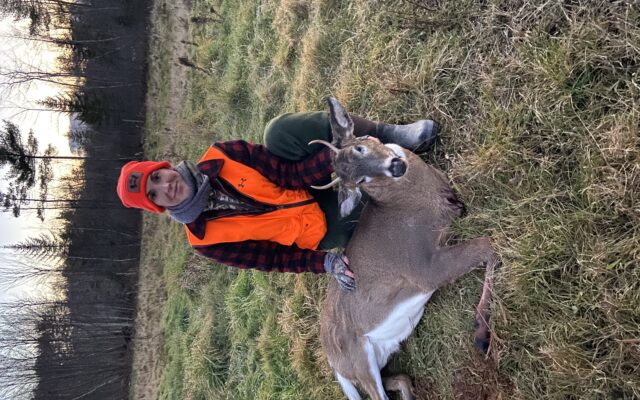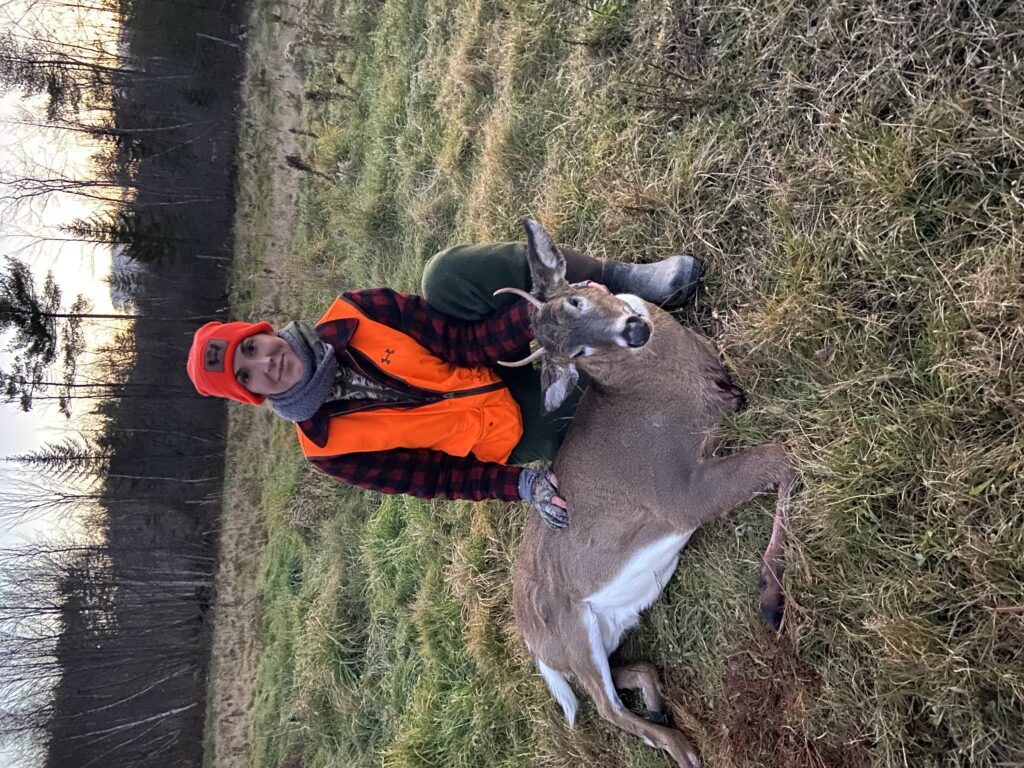
Killing and processing a deer deepens connections to age-old hunting traditions
By Christi Holmes
I knew it was dead. The small buck swayed back and forth and fell to the ground. I took my phone from the pocket of my orange vest, and with quivering fingers, called my mom.
“I got a deer. I did it.”
We both cried. My tears were tears of relief that I had made a good shot, and excitement and disbelief that everything had come together. I hadn’t missed, the deer didn’t smell me and bolt, and I hadn’t been scrolling on my phone when he walked by.
All the early mornings hunting before work and changing into my office clothes in my car had paid off.

DEER HARVEST – Bangor Daily News Outdoors contributor Christi Holmes harvested this 110-pound buck while deer hunting this season.
I unloaded my 7mm bolt action and slung it over my shoulder, too hasty to lower it from the tree stand with the rope I used to raise it up earlier that afternoon. I descended carefully down the stand, lowering the lineman’s safety rope attached to my safety harness as I went.
Feet on the ground, I inhaled deeply and reloaded my gun, just in case. I walked carefully the 100 yards or so toward my fallen quarry. Though I had watched the buck die, a part of me expected it to jump up and run off.
As I approached the deer, a distinct smell hit me — deer urine. The buck was young but it was rutting, and had been peeing on the tarsal glands on its legs as a way to express his readiness to breed. I stared at his chest. No rise and fall. I poked it with the barrel of my rifle. Nothing.
Blood stained the grass near its heart. I knelt next to it and sunk my fingers into its cappuccino-colored coat. It was thick and coarse. My heart ached for taking the life of such a beautiful creature. But to eat meat is to kill and if I was going to eat meat, I would rather the blood on my hands than pay someone else to have the blood on theirs. I was connected to my food; it was not just a Saran-Wrapped purchase of an unknown animal. Every bite would be appreciated and cherished.
It was a spike, with two, 6-inch antlers protruding from its head. It was the smallest deer I’ve ever shot, but I was proud of myself nonetheless. A single piece of clover hung from its mouth. Minutes earlier that clover was growing in the sun, then this buck came along and started to eat it, then I came along and killed the buck.
Despite how detached my daily life may be from the natural word, today I was just another animal on the landscape, doing what humans have done for millennia.
I dug through my backpack until I found my knife and removed it from its sheath. I rolled the deer onto its back and held it there with my left leg. Careful not to puncture any innards, I made a shallow incision below its breastbone. I switched to a gut hook knife and sliced the hide all the way down to the pelvis. With a regular knife, I cut a circle around the anus, detaching it, and with my saw blade, sawed through the buck’s pelvic bone.
Then I returned to its chest and cut the diaphragm and freed the stomach from the inside of the deer. Deep burgundy blood filled the body cavity and its lungs were reduced to sloppy congealed blood. That’s where my bullet had struck. Heat steamed from the blood and organs and warmed my hands as I worked.
I reached up as far as I could toward the deer’s throat, feeling around for the esophagus and cut it free. I moved my left leg and let the buck rest on its side. I pulled and scooped his insides out until they lay on the ground. The guts would be gone by morning, eaten by coyotes and raccoons. Nothing goes to waste in the wild.
Gently turning over the deer’s guts, I found a sac and cut it open until I was holding the deer’s heart. I thought about my heart and how it compared. I found the liver and set it aside with the heart to take home to eat. I wiped my bloody hands off on my pants and began dragging the deer in the direction of my car.